#stone's an archaeologist
Text

Archaeologists Find Statue of the Roman Sea God Triton in Mausoleum
Archaeologists have uncovered a Roman Statue of Triton during excavations in preparation for a housing development in Kent, England.
Archaeologists from the Canterbury Archaeological Trust (CAT) have discovered artifacts, including a mausoleum which is to be buried within a roundabout, which are more than 1,700 years old during an investigative dig related to a new housing development close to London Road in Teynham.
Robert Masefield, Director for RPS, said: “We expected interesting Roman archaeology, perhaps a cemetery, but the finds including the lively and unique statue of a Triton and the mausoleum remains have by far exceeded that. These finds are now part of Teynham’s local legacy and the nations rich Roman story. Further study will place the findings in their full historical context.”
The area, which is being built on by Moat Homes and Chartway Partnerships Group for its Frognal Lane development, follows the ancient Roman Watling Street and during an initial site evaluation, fragments of chalk wall foundations and Roman cremation burials were discovered. As a result, Swale Council, with advice from Kent County Council Heritage Conservation, required a 0.5-hectare archaeological excavation at the site.

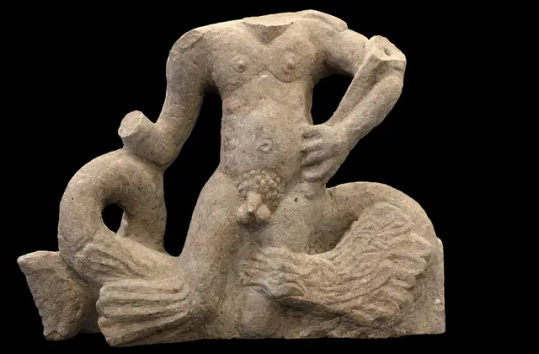

The Canterbury Archaeological Trust (CAT) was tasked with leading the dig, which revealed elements of a 30m square walled enclosure surrounding a c.7m square structure. Further excavations revealed that the structure is a Roman mausoleum containing a Roman coin dating from around 320 to 330 AD. The site also included Roman, and possibly later, burials with various grave goods.
However, the highlight of the findings was the discovery of a stone statue, representing the sea god Triton.
The Triton statue is substantial, appropriately 70cm (27.5 inches tall) and 70cm wide. It weighs more than 132lb (60kg). Archaeologists did not need to dig far. It was only 1.3 feet (40cm) below ground.
In Roman mythology, Triton was the son of Neptune, the god of the sea. The unique stone statue depicts Triton – a merman with the torso of a man and the tail of a fish – riding on a sea monster.
As a demi-god, he could calm the waves by blowing on his conch shell, which he appears to be holding in the uncovered sculpture. That part has been broken off, but the artifact is otherwise in incredible condition. It was carved between the late first century and second century AD.
Dr. Richard Hobbs, senior curator of Roman Britain at the British Museum, told MailOnline it is ‘spectacular’.
He said that, although a few fragments of Triton sculptures are known from Roman Britain, ‘nothing quite like this has been discovered before’.
Excavations are continuing at the site.
By Leman Altuntaş.
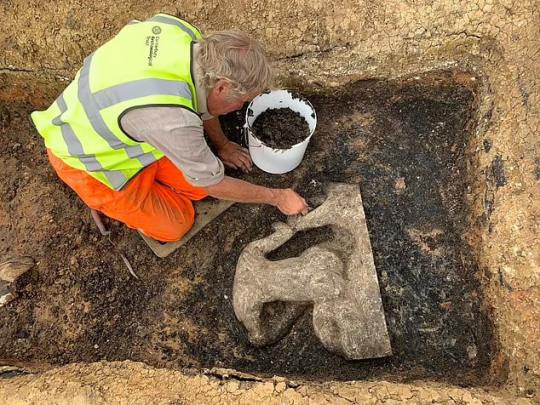
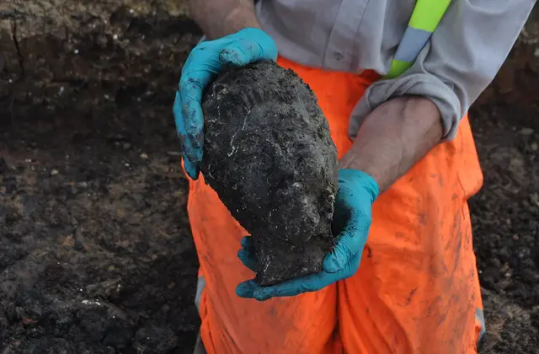

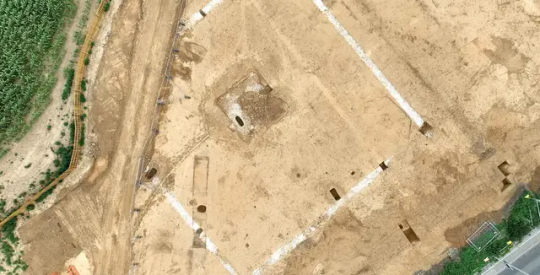
#Archaeologists Find Statue of the Roman Sea God Triton in Mausoleum#Kent England#The Canterbury Archaeological Trust#stone statue#roman statue#ancient tomb#ancient grave#ancient mausoleum#ancient artifacts#archeology#archeolgst#history#history news#ancient history#ancient culture#ancient civilizations#roman history#roman empire#roman art
218 notes
·
View notes
Text
Swastika/Hakenkreuz/Sun wheel/Wān/Tetraskelion

Perhaps one of the most controversial symbols in Europe all the while one of the most important symbols of Buddhism is the Swastika.
The Swastika can be found all over the world through time. From Iranian prehistory to Scandinavian Air Forces in the 1930’s, Native American symbolism and Indian (Jain) religious virtue.
Generally associated with the sun because of the widespread use of the Sanskrit word Swastika (conduct to wellbeing) and is literally used as a symbol for the Sun (Surya)
The orientation and color of the swastika, along with additional decoration of the cross itself is reflective of the people who used it and the meaning they attested to it.
The symbol was used since prehistory, corresponding to mankind’s love for geometry. It is believed that the European use for the symbol is to portray the sun’s pathway across the sky.
Swastika’s have been found on Runic Stones, petroglyphs, brooches, woven fabrics, pendants, etc.
Many researchers have their own individual interpretations for the use of Swastika’s in Europe as they are the least clear in meaning than the rest of the world’s. An example of this is not just the visualization of the passing of the sun, but a stylized image of lightning/a thunderstorm, thus referring to Thor.
Image: Snoldelev Stone (DR 248) (detail)
Found in: Snoldelev, Ramsø - Denmark. 9th Century A.D.
#rune stone#runic stone#runes#swastika#frankish#merovingian#viking archaeology#archaeology#carolingian#charlemagne#field archaeology#viking mythology#merovingian archaeology#germanic mythology#norse mythology#anglo saxon#field archaeologist#frisian#odin#viking#vikings#germanic#germanic folklore#germanic archaeology#wodan#anglo saxon archaeology#history#jewelry#norse#thor
7 notes
·
View notes
Note
Happy WBW!
🏛️ - Does your world have old buildings? Ruins?
happy belated worldbuilding wednesday :-)
and on god i love this question so muchhhh you have NO idea!! i'm an archaeologist so of course asja's world has to have some ruins, mostly based on real-life archaeology facts and observations i made across two continents over the past 3 years. here's whose ruins, and why they're ruins:
three thousand years before asja's time, the people living on the continent were different, more diverse. merpeople, witches, more kelpies and pixies and other fae, more non-human folks. queen lyeann and her healer caleides have just become legends, the fields are thrumming with magic, the sky burns red at sunset.
and then, the wrong humans with more influence than most of them are forced to face the harsh reality — that living in a magic world is hard for the non-magic people. that dying is easier and quicker as they thought. and they won't stand for it. so magic has to go. and it does, at first.
towers fall, castles are abandoned. the crypt where queen lyeann lies amidst her flowered chapel is sealed off and buried, a new temple erected directly atop of it — to make use of the religious mysteries for a new cult. the palace of the god of the hill lies in ruins and slowly vanishes under rolling, lush meadows, the entrances never to be found again. the ruins of the glasswalker's keep on sillave, thmai, more intricate and precious than any human castle could ever be, are still interlaced with the glasswalker's magic woven through it, slowly changing over time — plants grow faster there, children age slower, animals never set foot into it for fear of an untimely death. the rulers of sillave built a school in the keep's bone-white ruins, with stairs winding on the outside of the fallen towers like bracelets, barely-aging child-scholars scurrying about.
but the old ways are coming back, now. at last, humans have bitten the hand that feeds them: for centuries, most witches have helped them (or at least, not opposed them) in their task to end the use of magic, foolishly thinking they'd be excempt from the humans' verdict. when there were barely any common enemies, witches became the new target. and now, they're almost as extinct as glasswalkers and faeries. humans have forgotten that witches used to be the only thing standing between them and the magic beings they tried to eradicate, and exactly these decimated species are making a comeback, and noone's powerful enough to stop them on their way towards emperors and queens alike.
and the scattered ruins will shine and rise again, one way or another.
#writing#ask game#my writing#willows in gold#writblr#gremlin speaks#yes i'm an archaeologist yes i think way too much about what remains. especially stone and ceramics. especially buried ruins and how#characters interact with them#i could go on and on and on!!! about this!!!#sorry for the english i know the style isn't good but it's past midnight and i'm tired!! not that german would be any better tho.. :-)
6 notes
·
View notes
Text
Mesolithic find of the day

#stone age#middle stone age#mesolithic#Indiana Jones#silex#geology#geography#history#archaeology#archaeologist#field archaeology#field work
37 notes
·
View notes
Text
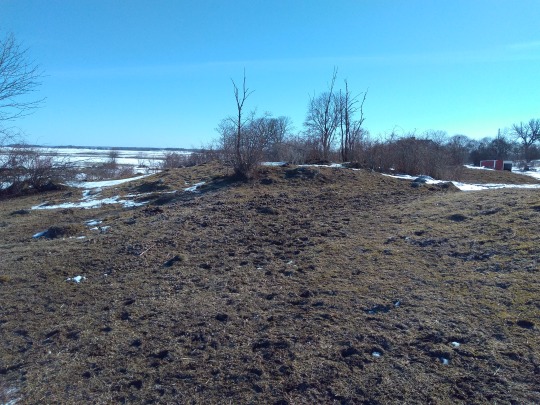



Photos from a preliminary archaeological survey
#the site is Ekeby in Sweden#it was for one of my courses#the photos are from april#hence all of the snow#i'm going through all of my old photos lol#archaeology sites#sweden#history#landscapes#archaeologist#archaeology#stones#dark academia#studyblr#gradblr#academia#field trip#my post#photography#my photos
16 notes
·
View notes
Text

The Ker-Han dolmen is a neolithic dolmen transported from its original site in Morbihan by the archaeologist Jean-Baptiste Piketty (1827-1894 CE), to serve as his family's tomb in the Longs Réages cemetery in the southern suburbs of Paris.
#neolithic#dolmen#grave goods#stone age#morbihan#archaeology#meanwhile in france#average french archaeologist
2 notes
·
View notes
Text
The Crossroads [DLC Trespasser]: Unknown Ruin

This particular section of the Deep Roads seems to have been abandoned. It connects to a former lyrium mining site of unknown origin, which contains statues of Mythal, Fen'Harel, and of an unknown creature. Unlike dwarven constructions, this location lacks the usual lightning and heating produced by moulting rock, turning it unusually dark. There is no trace of darkspawn activity either.
This place is divided into
Overlook
Excavated Caves
Lower Walkways
Unknown Ruin
[This is part of the series “Playing DA like an archaeologist”]
[Index page of Dragon Age Lore]

Once we visit the Lower Archives and the Scholar’s Retreat, we have access to a discharge power that blows rubble away and it can be used in the Deep Roads section against a rubble-blocked door. Free, we can see an eluvian inside a small room.
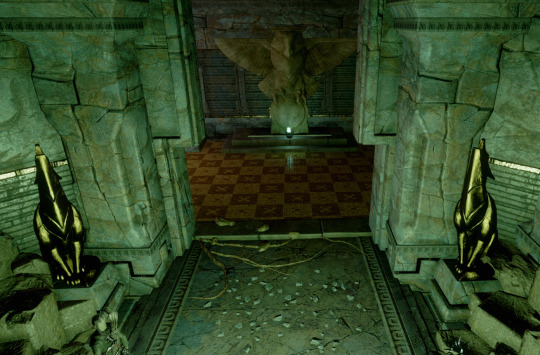
When we step into the eluvian, we are transported to an Unknown Ruin of dwarven architecture with Elvhen decorations: four golden Howling Fen'Harel statues and an Elven Owl statue welcome us. The Fen'Harel statue may represent protection of this place, while the owl, a "secret to keep". These concepts seem to coincide with what the Dev’s note says for this room: a place where Solas reached to the conclusion that the Evanuris needed to be stopped, but their actions had to be kept in secret in order to avoid anyone else to be tempted of repeating their actions [More details in Murals in DAI].


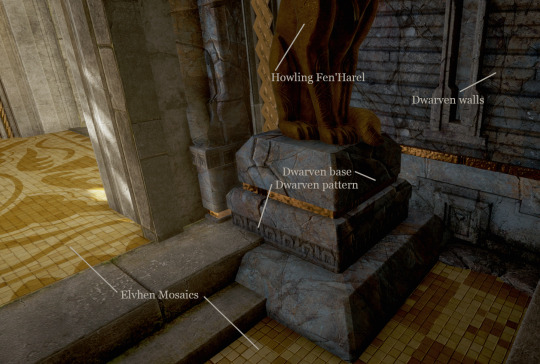
If we see the details of the corridors, they are a rich combination of dwarven and elvhen styles: elvhen statues on dwarven-made bases. The walls are dwarven and show dwarven patterns, sometimes decorated with the golden lines or golden helicoids proper of elvhen design.

The Elven Owl statue has Veilfire at its talons which is expected. If this statue is related to Dirthamen and secrets, it seems reasonable to see it as a source of Veilfire, with which the secrets are revealed. Fen’Harel howling wolves sit at its sides, again, almost as if he were guarding this entrance. We have seen this configuration with Mythal before: the central statue is in a position that means “being honoured”, while the wolves around it represent “protecting it”.


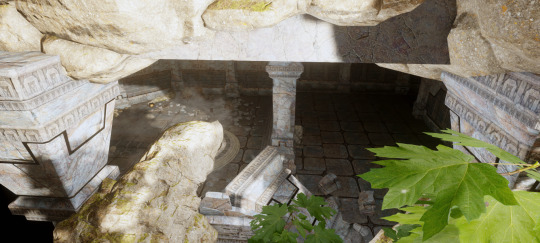

The small corridor we follow has typical decorated elvhen mosaics on the ground [which contains the asterisk symbol], as the walls are made of dwarven style, and decorated in golden with elvhen patterns. The ceiling is a combination of elvhen and dwarven styles. I don't know where in Thedas this place is located, since we came here through an eluvian in the Deep Roads, but what we can know for sure is that this dwarven-elvhen ruin is on the surface: we can see the Sun entering the room through the hole in the ceiling.

The corridors lead to a small room with a big mural.
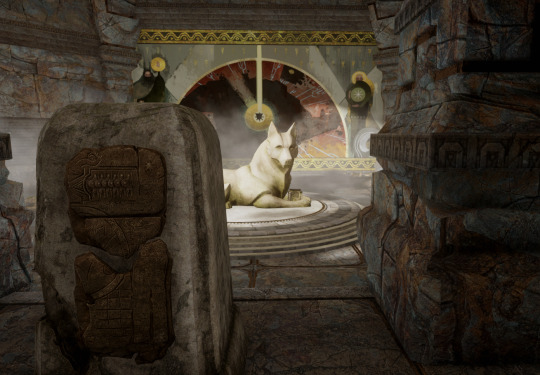
Like in all the places where we find a Sitting Fen'Harel statue with an elven box in its paws, we know that a puzzle must be solved. As usual, there is a Stone in Razikale-Ceremony-style which gives instructions about it.


At a corner of the room, we find two Howling Fen'Harel statues, one fallen, the other broken, and a golden Elven Owl statue. It looks like there was a secondary altar here, with the golden figure in the middle of the two Fen’Harel statues. Here, the symbols again seem to relate in some way to Dirthamen with Solas. The pattern that Dirthamen is always around Fen'Harel's business is something that is repeated quite frequently, especially in Trespasser, but the exact relationship to understand it is never given.
------------- A brief comment apart ------------------
Note: Even though one would think that the Owl statue is an undeniable symbol of Falon’Din, along all the posts we were visiting so far we have noticed an overlapping of “associations” for this animal:
The owl is related to secrets and Dirthamen [The Lost Temple of Dirthamen shows a link between this statue and “a Path of secrets”, plus the whole Temple seem to imply knowing secret, horrifying spirit-bind processes that may or may not include Falon’Din].

Tevinter art has an Arcane Flag where it’s obvious that represents an elvhen owl statue. This gives us an idea that magical knowledge is related to this symbol simply because Tevinter co-opted it from the Elvhen.
The relationship of the Owl with Falon’Din only belongs to the unreliable Dalish tales, as well as Dirthamen’s two ravens. This may represent that Dirthamen’s symbol was attributed to Falon’Din by accident given the strange symbiotic and inseparable relationship that Dirthamen and Falon’Din have.
And in a less popular way, the owl has also been attributed as the messenger of Andruil [ Andruil's Messenger]. This knowledge is also based on the unreliable Dalish Tales.
In conclusion, the owl is not exactly an animal we can link to any of the three Evanuris [Dirthamen, Falon’Din and Andruil] with a strong degree of certainty. However, to me, the strongest proof is the Tevinter Flag. The owl is related to arcane knowledge, and The Lost Temple of Dirthamen has shown us that Dirthamen has knowledge of bounding processes, strange manipulations made by Ghilan’nain [Her red mosaic and potential connections to The Horror of Hormak], and maybe including the scaled ones [given the paintings in his Temple]. It is also true that all of this may end up applying to Falon’Din due to the curious lack of any representation of Dirthamen in his own Temple and a lot of iconography of Falon’Din, but that may be attributed to their “twin” nature, that must mean a lot more than the Dalish Tales grasp.
Still, for simplicity’s sake, I will keep saying for this particular post that the owl represents Dirthamen but keep in mind the fragile pieces of information we have about this symbol.
For more details about the relationship between Falon’Din and Dirthamen, check Humanoid Dirthamen, the two parts of The Lost Temple of Dirthamen, and Ancient Elven codices; The Lost Temple of Dirthamen.
------------------------------------------------------
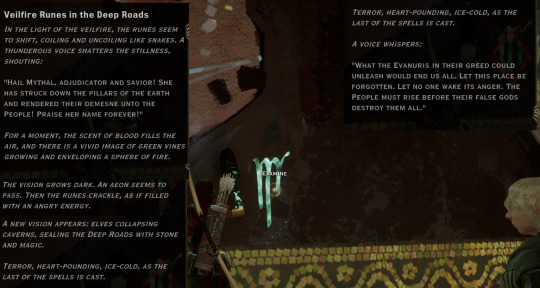
Once we solve the puzzle with the very creepy Sitting Fen'Harel statue, we can read one of the most important codices in Trespasser: Veilfire Runes in the Deep Roads.

The inquisitor gives us a bit more of context: the Evanuris fought the Titans, mined their bodies for lyrium [which is a reinforcer of reality and shape that they may have used to develop a slavery system based on Vallaslins], and “something else”. This “something else” may represent some forbidden or ugly magical procedure [hence the presence of the owl statue as a symbol of secret but also arcane knowledge] .

With Cole's cryptic messages at the Winter Palace, we can suspect that the Evanuris began to create bodies from the earth, and used the Vallaslin based on lyrium as a way to "reinforce" shape onto their own kind, maybe bounding the elves into these bodies. Metaphorically, it is a similar process to the creation of Golems that has been explained to us in DAO, with Caridin's Journal. Both final creatures are slaves.
According to Cole’s cryptic line, we can infer that this may have the cause for the Titans to feel the need to fight the elvhenan back: the titans saw in the ability to create bodies of the elvhenan a danger or an abuse, while the Elvhenan felt threatened by the Titans due to the shakes their creation process caused in the elvhenan cities.

The veilfire brazier is located on the heart of the Titan, drawing all our attention to it. It has the same symbol that the orb held by the elvhen at the right. This asterisk symbol has appeared in other murals as well and I think it’s safe to associate it with the heart of a Titan thanks to this mural. It’s also where you put Veilfire. More details about this mural in Murals in DAI.


When we solve the puzzle, we obtain the Heart of Pride, a staff that, in my opinion, is not the one we see in most of Solas’ murals. The model for the Heart of Pride is a twisted branch with two dogs tied to it. Looks more Alamarri than elvhen in design.

The staff we see that Solas has [1, 3, 4] is more similar to a head of a Halla with strange, messy horns. The option [2] may not even represent Solas, as we discussed in Forgotten Sanctuary.
The description of Heart of Pride doesn’t add anything extra. It’s in any case creepy: laughter of pride while Fade energy clings to the staff, as if an echo of creatures of pride, diluted in this Fade energy, were desperately trying to reach to this feeling that this staff gives to its user. We don’t even know if it’s elvhen-made.
#deep roads#dai trespasser#dlc#Playing DA like an archaeologist#solas#titan#Sitting Fen'Harel statue#Howling Fen'Harel statue#Elven Owl statue#Stone in Razikale-Ceremony-style#asterisk symbol#dwarven design#elvhen design
30 notes
·
View notes
Note
What's the coolest manuport you've ever found? Like one that made you be like "yknow what dead guy? You've got good taste, I'd've absolutely yoinked that in your place"
oooh honestly i reckon it was just this like... INSANELY round river pebble. Like the kind that sat really well in the hollow of your palm. And i was like Solid Choice™ my dude i do in fact approve of this one.
#we were too far away from the water for it to not have been carried there#honourable mention to the collection of ones one of the other archaeologists pointed out would have made really good slingshot stones#but honestly like a lot of our manuports are more like#''that is... not a material you get here? someone had to bring that''#more than being like ''this is a Cool Rock''#bc unless its a Cool Rock thats a whacky material#you dont know its a manuport#(tragically)#but yeah the river pebble#(i'm getting more asks now and its honestly lots of fun?)#archaeology#they let a mouse do archaeology?#Mice answers things
5 notes
·
View notes
Text


for my swirl girls
#swirl#nature#spirituality#crystal#crystals#earth#mineral specimen#geology#mineralogy#minerals#moodboard#fossil#archaeologists#archaeology#rock#stones
21 notes
·
View notes
Text
documentaries with archaeology are always like "as we can see these stones were carefully selected and placed and the brand new tools in amongst them must have been put here for a reason. clearly this was a sacred site!" and it's just a pile of rocks, some of which are sharp
#also maybe there were new tools because they accidentally dropped them while walking down the road?#i mean presumably these professional archaeologists know way better than me#but sometimes they're like omg look at this fancy stone axe!#and it's just#a rock#misc
2 notes
·
View notes
Text
A shirt that says: I'm an archaeologist, I baffle easily
#because that's apparently all we do...#archaeology#archaeologists#archaeologist problems#written in stone
3 notes
·
View notes
Photo






Archaeologists Discover 1,000-Year-Old Mayan scoreboard in Mexico
A stone scoreboard used in an ancient soccer-like ball game has been discovered at the famed Mayan Chichen Itza archaeological site in Mexico's Yucatan peninsula, archaeologists said this week.
The circular piece, measuring just over 32 centimeters (12.6 inches) in diameter and weighing 40 kilograms (88 pounds), displays hieroglyphic writing surrounding two players standing next to a ball, according to a statement from Mexico's National Institute of Anthropology and History (INAH).
"In this Mayan site, it is rare to find hieroglyphic writing, let alone a complete text," said Francisco Perez, one of the archaeologists coordinating the investigations in the Chichanchob complex, also called Casa Colorada.
The stone, believed to be a scoreboard, dates from between 800 AD and 900 AD.
The ball game was a traditional practice of Mesoamerican peoples and is believed to have had ritual undertones.
INAH researchers are now preparing to take high-resolution images of the text and iconography for detailed study, while preparing it for conservation.
The Chichen Itza complex, declared a World Heritage Site by UNESCO, is one of the main archaeological centers of the Mayan civilization in the Yucatan Peninsula. According to official data, about 2 million people visit the site every year.
#Archaeologists Discover 1000-Year-Old Mayan scoreboard in Mexico#Mayan Chichen Itza#stone tablet#archeology#archeolgst#history#history news#ancient history#ancient culture#ancient civilizations#mayan history
214 notes
·
View notes
Text
youtube
'The stone is a symbol of cultural imperialism' — Egyptian archaeologists are calling for the return of the Rosetta Stone, a 2,200-year-old artifact that was taken 200+ years ago
For more world news, subscribe to NowThis News.
#rosettastone #egypt #history #Politics #News #NowThis
#now this news#now this#solarpunk#Rosetta Stone#egypt#imperialism#cultural imperialism#Monica Hanna#archaeologists#Egyptian archaeologists#archeaology#cultural violence#French#British#british museum#UK#england#colonialism#Youtube
8 notes
·
View notes
Text
Archaeologists Excavating the Tomb of Egypt’s First Female Pharaoh Found Hundreds of Jars Still Holding Remnants of Wine
The dig has also shed new light on the reign of the ancient queen.
— Adam Schrader | October 18, 2023
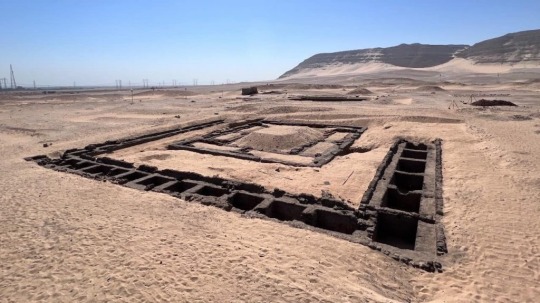
An archaeology team has discovered evidence that the Ancient Egyptian Queen Merneith “had a great position” and was responsible for the central government offices. Photo courtesy of Egypt’s Ministry of Tourism and Archaeology
Archaeologists digging in one of the oldest cities in Egypt have discovered evidence that sheds new light on the life of the ancient Egyptian queen Merneith, who ruled during the 1st Dynasty.
The excavation of a tomb in the Umm al-Qaab area in Abydos found an inscription on a “Stone Vessel” that provides new historical information about Merneith’s reign, during which she held “A Great Position” and was responsible for the central government offices, said Christiana Köhler, who led the dig.
“It has been speculated that Merneith may have been the first female Pharaoh in Ancient Egypt,” Köhler said in a news release, “but her true identity remains a mystery,”

A fragment of a stone vessel recently found in the tomb of Queen Merneith. It has an incised inscription with her name on the right and the mention of the royal treasury on the left. Photo courtesy of EC Köhler, M Minotti.
Köhler specified that Merneith, also known as Meret-Neith, may have been in charge of the treasury among other government offices, supporting the idea of her historical significance. She is the only 1st-Dynasty woman whose tomb has been uncovered in Abydos so far.
“Considering that these are the remains of people’s lives and actions from 5,000 years ago, we are stunned every day at the amazing detail we encounter during our investigations, including the perfectly preserved grape seeds, craftwork and even footprints in the mud,” Köhler said over email.
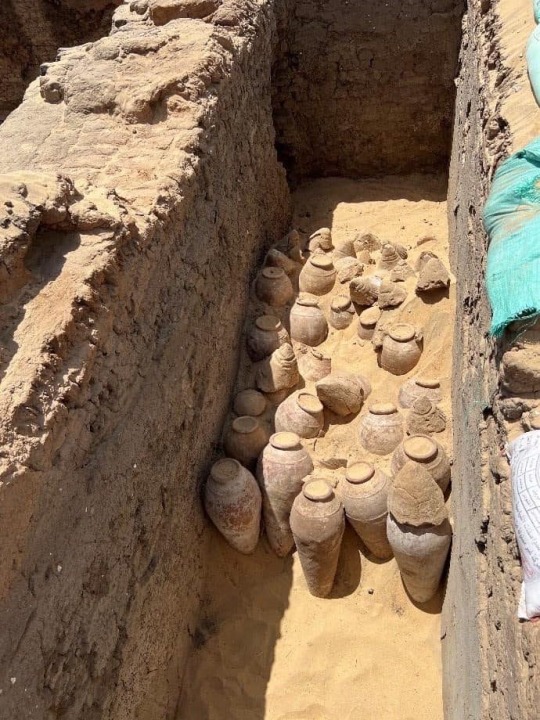
The Wine Jars are seen during the excavation of Merneith’s Tomb. Photo courtesy of Egypt’s Ministry of Tourism and Archaeology
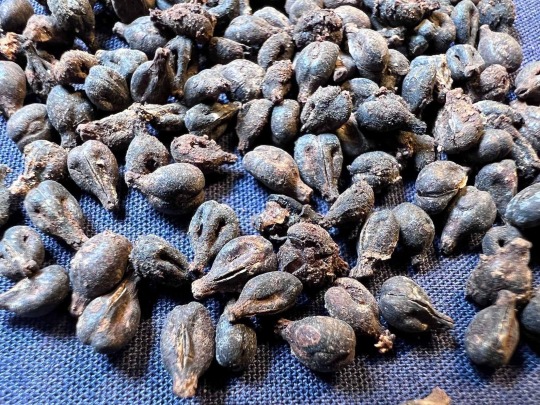
Perfectly Preserved Grape 🍇 Seeds: Egypt’s Tourism Ministry highlighted hundreds of 5,000-year-old wine jars found in the tomb in the Umm al-Qaab area in Abydos, one of the oldest cities in Egypt located about 354 miles south of Cairo. Photo courtesy of Egypt’s Ministry of Tourism and Archaeology
Discoveries made in the dig also “challenge the long-held belief in human sacrifice,” Köhler added in the news release.
Next to Merneith’s burial site, archaeologists found a group of 41 tombs for her courtiers and servants, indicating these chambers were built during different periods of time.
“This observation, together with other evidence, radically challenges the oft-proposed, but unproven idea of ritual human sacrifice in the 1st Dynasty,” Köhler said.
The news release highlighted the discovery of hundreds of 5,000-year-old wine jars that had never been opened. The archaeological team—hailing from Egypt, Germany and Austria—found the remains of wine inside.
Mustafa Waziri, Secretary General of Egypt’s Supreme Council of Antiquities, said in a statement that the discovered jars are large in size and “in a good condition of preservation.”
“Some of them are very well preserved with their jar stoppers still intact,” Köhler said.
#Archaeology#Ancient Egyptian QueenMerneith#Egypt 🇪🇬#Egypt’s First Female Pharaoh#Archaeologists | Jars 🫙 | Wine 🍷#Tomb | Umm al-Qaab area | Abydos#1st Dynasty#Egypt’s Ministry of Tourism & Archaeology#Stone Vessel#Christiana Köhler#Preserved Grape 🍇 Seeds | Craftwork | Footprints 👣#Mustafa Waziri | Secretary General | Egypt’s Supreme Council of Antiquities
0 notes
Text
Fascinating discovery!
Also, scroll through the equally interesting stories listed after the article!
0 notes
Text
Hissing Wastes: Fairel tomb

The Hissing Wastes is a large stretch of desert in western Orlais. Thousands of years ago, Paragon Fairel fled to the surface with his clan to escape a catastrophic civil war among the dwarves waged with his inventions and founded Kal Repartha, the only known thaig built on the surface. The Venatori are searching the ruins of the long-abandoned colony for the powerful runes that Fairel created. Like Western Approach, the Hissing Wastes used to be a lush forest, before encroaching sands destroyed the trees' roots.
[This is part of the series “Playing DA like an archaeologist”]

Fairel’s tomb is located in the East, where a dragon built a nest. The place, decorated with paragon dwarven statues and warriors, is sealed with a special key which parts can be obtained along the many smaller tombs and burials we find in the region.

One of the first tombs we visit to start assembling the key of Fairel’s tomb is Burial Grounds. Decorated with the usual paragon statues, it shows something unique so far:

On the same piece of stone decorated with a dwarven pattern, we see one of these stones that, so far, we have only seen related to ancient elvhen ruins. These stones have been seen in the elven ruins of Exalted Plains co-opted by the Chantry after the Exalted March; at the entrance of the Solasan temple in Forbidden Oasis; and in Razikale Reach [meaning this place was erected around or over an elven ruin, or simply Tevinter co-opted these stones as well]. The proof that these stones are ancient elvhen is in the forgotten elven temple in the Frostback Basin as well as in Solasan in Forbidden Oasis: both ancient elvhen tombs that were never disturbed before since the shards are only visible now with the help of the oculara.
There is a constant use of this stone in ancient elvhenan-related spaces to simply assume this is a merely reuse of assets. Maybe these surface dwarven incorporated elvhenan elements in their tombs if they had some potential involvement with Tevinter [who co-opted as many elvhenan elements as possible]
Truth be told, style-wise, this stone displays more resemblance to the lids of Razikale Ceremony and Horned warrior holding a sword than to any elvhen art we saw so far. The warriors with shields and spears are the same ones that appear at the bottom of the lids of Razikale Ceremony and Horned warrior holding a sword. So I'm not so sure why they appear inside the ancient elvhen tombs. Logically speaking, the ancient elvhen tombs existed before than any dwarven or Tevinter civilisation, so the chances for the lids to be elvhen is higher than to be Tevinter. Still, the style is so different to what we've seen in elvhen murals and paintings that makes me suspicious.

To have some clarification, we obtain the landmark The Empty Square, saying that this is a bas relief of an enormous, helmeted dwarf, flanked by two smaller dwarves, marching out of a mountain under a beaming sun. Clearly it's the depiction of Fairel and his two sons, so probably in this case this stone is a reuse of assets because there is no way to see that description in the object.


Anyway, these tombs will update a codex called Dwarven Inscriptions: Hissing Wastes, in which we are narrated the story of paragon Fairel and his two sons:
Fairel built with the help of his sons a Thaig on the surface that was as good as any other underground .
It implies that Fairel fled the underground because his own creation, a kind of particular weapon, crafted strife that destroyed thaigs and clans. It seems that the war between clans escalated with the development of Fairel’s weapons, so he “hid from the war” on the surface.
After years, Fairel dies of age and makes his sons promise to take care of each other. His sons crafted monuments in his honour [so I suppose many of those paragon dwarf monuments along the Hissing Wastes are meant to be Fairel] and locked away their father’s great works: a rune.
Each of his sons ruled half of the Thaig, but since they ruled differently, frictions arose, ending up in a duel where one of them killed the other. The winner ruled the whole Thaig and erected halls to mourn his brother.
It’s explained that pride had a lot to do with the story of Fariel and his sons.

In each of these burials we find a key fragment.

These burials have patterns of undeniable dwarven style: the C pattern, the geometrical doors, general lines of geometrical design.


As it has happened with the The Lost Temple of Dirthamen, these tombs are more or less all the same, displaying similar elements in different configurations. They are decorated with two types of dwarven statues and most of these burials have three main stone-paintings,

one of them we saw a lot in DAO, related of how the dwarves work the stone,


the other two show a tower/building that has strong reminiscence of the Gallows in Kirwall. These paintings have been present in DA2.



We can see a lot of elements clipped in strange ways to give the sense of “different” or “odd” room while still keeping the dwarven style: the elven trees in dwarven style are fused into the columns, as well as the head-part of the dwarven sarcophagi. The patterns are dwarven without any doubt.

Among the unusual details we find in these tombs there is this one which triggers the codex Demons of the Stone where a magister Venatori studies and wonders about the defence system that these tombs have. We learn that lighting the torches [of veilfire] in a wrong order summons demons, which is quite a feat for dwarves-made artefacts. Someone who seems to be a mage or specialised on bounding souls to the stone adds at the end of this codex several things:
The demons are bound into the rock. Which is a big warning for the player; this may imply two potential answers:
Fairel's dwarves could have been something close to mages [Like Valta?].
Fairel's dwarves had intimate relationships with mages [AKA Tevinter], which is a reasonable option considering that in one of these tombs we find Claws of Dumat. So, they may have strengthen their relationship with Tevinter once they reached the surface.
The magister in this codex thinks about the Gangue, an old concept that appears very briefly in DAO. The dwarves think The Stone as balanced but not pure. It contains an "ancient corruption" that only the Legion of the Dead can face, it's a "darkness" [once more, another reference to a darkness that could have implications with the Blight] that only they can cut away. This magister Gallus reads the word Gangue in the walls, and despite making a study about these demons, he can’t have any conclusion because they are dormant in the stone.

As an extra detail: when demons are triggered in these tombs after lighting up the braziers in an incorrect order, Cole will say a line which implies that these demons are spirits of dwarves, they still think themselves as such, but they sound ancient and old like dust. [Personal comment: It’s interesting that few centuries later after Fairel reaches the surface, the First Blight hits and Caridin develops a kind of forge-technique with the Anvil of Void that “bounds” dwarven souls to stone golems, making them alive. I’m not sure if maybe Caridin and Fairel clans are slightly related, but we can see there is a slight pattern in the sense that dwarves, or at least a part of them, had ancient knowledge of how to bound living souls to the Stone.]

Another detail that makes us suspect that these dwarves may have been related to Tevinter, or developed themselves mage dwarves, is the presence of veilfire runes. We know from codices and notes from Fare Mire and Hinterlands that any mage can learn to craft these runes in veilfire. It’s a matter of practice. But it’s an art that needs a mage. Also, the shape of this sigil is the same one we see in Tevinter ruins, not in Elvhen ones.


Another unusual tomb is this one in which the ceiling fell apart, and from an urn or vessel some plants grew. It doesn’t have anything different to the others burials except for the plant on the table, and our old mysterious friends:


The old, mysterious Claws of Dumat.
Fairel, Paragon, fled from the strife his brilliance created,
the strife that destroyed thaigs, sundered houses, from weapons that clan used against clan.
His own clan and his two sons followed Fairel to the pitiless surface,
the surface where they would hide from the war that took their home.
The exact part of the story that this burial has is the one related to the exodus of Fairel and the causes of it: his weapon, which caused strife and destroyed clans. This is the main reason why I think Fairel’s house, as runecrafters, may have helped magisters to create Kirkwall [which is built following glyphs and runes patterns]. We know from the Fade that these Claws of Dumat help to potentiate spells through blood sacrifices. Maybe unwillingly, Fairel ended up being involved with the Tevinters that stepped into the Fade. There is clearly a link between these ruins and Corypheus: Corypheus used these altar-claws as an innovation to improve the Tevinter spells when he was still a human, and he also knew about these ruins, thus he commanded Venatori to dig them.
Also, the presence of Tevinter elements here must have been brought in the past, during the ancient times, for sure in the times of Corypheus when he was a human magister, since these ruins where not known by anyone until now: it was Corypheus who informed the Venatori about them, and the Shaperate never knew about them since they “recorded Fairel as dead”. So I think it’s reasonable to keep supporting the idea that these ruins were involved with the ancient Tevinters.


If we enter to the chamber where the main sarcophagus is buried in this tomb, meaning the next room after the one with the claws of Dumat, we see a better decorated chamber which has one stone-painting hanging: the one that displays Kirkwall, the gallows.

Bellow each stone-paintings there are seats. On the table, and in front of the sarcophagus, we have the urn.

Each of these dwarven seats have a very alarming decoration. If we see closely, the decoration has swirl engravings, and thorny vines coming out with fire or thorns from a kind of flower or arch, below which we see a Sun. This decoration seems to call some elements from the mural of “The Death of a Titan” and specifically from the codex Veilfire Runes in the Deep Roads. However, this seat is not truly “dwarven”, but Elven. We can find this same object that is attacked to the back rest in several elven-related places, such as Serna’s tomb in the Hinterlands, beside the statue of the “maker” during Tyrdda Bright-Axe Path in the Hinterlands, and in elven temples such the one we visit for Cradle of Sulevin.


The DLC of Jaws of Hakkon showed us that places with strong leaks into the Fade sometimes can produce an over-healthy, colourful overgrowth, and make time pass slower so the objects in this zone have resistance to decay and erosion; they are _preserved_ despite the conditions they are under. Somehow, I feel a similar effect has been hinted here in this tomb. The roots of the trees should have been died with the sand, as the codex of the region tells us, yet, we see deep roots on the ceiling.

In one of the last burials we visit, we see the three stone-paintings perfectly clean: there are three images: the work on the stone, used in DAO, the image of Kirkwall/gallows, used in DA2 and the central one, which is a tower that looks like the central part of Kirkwall, which was seen in DA2 as well. Below this stone-painting we see a broken urn on a seat.
Fairel’s tomb

When we reach the entrance of the tomb of Fairel, as a small curious detail, we see that on the top of one of the columns, there is a small altar to a golden Dragon Mythal statue. It’s a very odd place to find an elvhen element. Maybe some passing group of Dalish or maybe just one elf [since there is only one single candle] left it there recently.

Finally, once we access to the Fairel’s tomb, we see two warrior statues resting they weight on their swords. I assume, given the context, these are Fairel’s sons. The central part of this chamber is a dwarven sarcophagus in front of a table which contains an urn, scrolls, books, etc. All over the place we can see the typical geometrical patterns of the dwarven style.

In here we see only two stone-paintings: the one that shows the work on the stone, and the other which is kirkwall/the gallows [Are these Fairel’s works as well? Nothing can clarify this doubt]. We find Fairel’s main “work” that his sons sealed with his body: it’s a strange rune, but the game never again focused on this rune, so It’s not even clear if the treasure is gone or this is all what it is and the game doesn’t care to spoil us more.
Among the loot that we find here, the only decent items is a dagger called Promise of the Storm which description cannot be more vague. Clearly it's ancient but we can’t say nothing more than that. Could it have been done by Fairel? Is it part of the many treasures crafted by Fairel? Not a clue.
[Index page of Dragon Age Lore ]
#dwarven design#Dwarven sarcophagus#Dwarven stone-paintings#Stone in Razikale-Ceremony-style#Claw of Dumat#Thaig#Gangue#Playing DA like an archaeologist#Dragon Mythal statue#thorny vine#thorny roots
19 notes
·
View notes